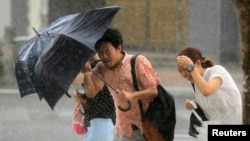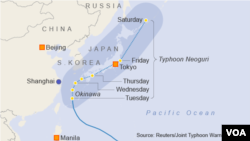Torrential rains from a weakened but still dangerous typhoon battered Japan's Okinawa islands on Wednesday, leaving two dead and threatening widespread flooding as the storm headed for the nation's main islands.
In addition to the two people killed - both fishermen - at least 28 were injured as the storm moved across Okinawa on Wednesday, leaving 52,000 houses without power.
The main airport on Okinawa reopened Wednesday, although some morning flights were canceled. Spokesman Takumi Higa said no damage had been reported.
Though it has weakened, Neoguri is still packing wind gusts of up to 162 kilometers per hour. But the main concern now is the slow-moving storm's heavy rainfall.
Authorities warned of record rainfall in Okinawa as rivers in some areas overflowed. More than 200,000 residents were told to leave their homes, down from over 500,000 on Tuesday.
Landslides, flooding feared
Forecasters warn that the island of Kyushu could see at least 300 millimeters (12 inches) of rain in a 24-hour period through mid-day Thursday.
Airports in Kyushu were still open, but late flights were canceled.
Kyushu's Fukuoka Prefecture issued warnings for strong winds, high tides and heavy rains, and advised people to stay indoors as much as possible.
Satoshi Ebihara with Japan's Meteorological Agency (JMA) warned that a serious disaster is still possible, including landslides and flooding.
"This is an abnormal situation with impending serious danger. This is a situation where it would not be surprising for a serious disaster to have happened by now," said Ebihara.
By Wednesday afternoon, the typhoon was churning in the East China Sea, and heading toward southern Japan. Round-the-clock television footage pinpointed its latest location and helmet-clad reporters surveyed the damage left by the powerful storm.
In Naha, Okinawa's capital, traffic lights went out and television footage showed split trees, signboards flying about and a destroyed restaurant, with the shattered building blocking a street.
The storm is expected to hit Kyushu early Thursday before heading for Honshu, Japan's main island where Tokyo and Osaka are located.
Nuclear plants shut
There are two nuclear plants on Kyushu and another on nearby Shikoku island.
All of Japan's 48 nuclear reactors are shut down three years after the disaster at the Fukushima Dai-ichi nuclear plant, which was wrecked by an earthquake and tsunami in March 2011.
The stricken plant is on the other side of the country.
Nansei Sekiyu KK, a Japanese refiner wholly owned by Brazil's Petrobras, suspended operations at its 100,000 barrels-per-day Nishihara refinery in Okinawa on Monday evening and still had not resumed on Wednesday.
Tokyo may see heavy rains on Friday but the impact on the capital is otherwise expected to be minimal, the JMA official said.
Japan usually is hit by several typhoons each year, but it is unusual for such a storm to hit as early as July.
Some information for this report provided by Reuters, AFP and AP.


